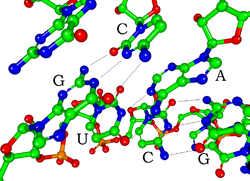RNA

RNA is an acronym for ribonucleic acid, a nucleic acid. Many different kinds are now known.[1]
RNA is physically different from DNA. DNA has two strands that twist around each other, but RNA only has one strand. RNA also has different bases than DNA. These bases are adenine, guanine, cytosine, and uracil.
Adenine bonds with uracil. Guanine bonds with cytosine. In this way, we say that adenine is complementary to uracil and that guanine is complementary to cytosine. Adenine, guanine and cytosine are also in DNA. In RNA, uracil replaces thymine as a complement to adenine.
RNA also has ribose. This is different from the deoxyribose in DNA. These differences result in RNA being more chemically reactive than DNA. This makes it the more suitable molecule to take part in cell reactions.
RNA is the carrier of genetic information in certain viruses, especially retroviruses like HIV. This is the only exception to the general rule that DNA is the hereditary substance.
Protein synthesis RNAs
Messenger RNA

The main function of RNA is to carry information of amino acid sequences from the genes to ribosomes in the cytoplasm. Ribosomes are where proteins are assembled.
This is done by messenger RNA (mRNA). A strand of DNA is the blueprint for the mRNA which is transcribed from that DNA strand. The sequence of base pairs is transcribed from DNA by an enzyme called RNA polymerase. Then the mRNA moves from the nucleus to the ribosomes in the cytoplasm to form proteins. The mRNA translates the sequence of base pairs into a sequence of amino acids to form proteins. This is called translation.
DNA does not leave the nucleus for many reasons. DNA is a very long molecule, and is bound in with proteins, called histones, in the chromosomes. mRNA is able to move and react with many cell enzymes. The mRNA leaves the nucleus and moves to the ribosomes after it is transcribed.
Two kinds of non-coding RNAs help in the process of building proteins in the cell. They are transfer RNA (tRNA) and ribosomal RNA (rRNA).
tRNA
Transfer RNA (tRNA) is a short molecule of about 80 nucleotides which carries a specific amino acid to the polypeptide chain (the protein being made) at a ribosome. There is a different tRNA for each amino acid. Each one has a site for the amino acid to attach and an anti-codon to match the codon on the mRNA. For example, codons UUU or UUC code for the amino acid phenylalanine.[2]
rRNA
Ribosomal RNA (rRNA) is the catalytic component of the ribosomes. Eukaryotic ribosomes contain four different rRNA molecules: 18S, 5.8S, 28S and 5S rRNA. Three of the rRNA molecules are synthesized in the nucleolus, and one is synthesized elsewhere. In the cytoplasm, ribosomal RNA and protein combine to form a nucleoprotein called a ribosome. The ribosome binds mRNA and carries out protein synthesis. Several ribosomes may be attached to a single mRNA at any time.[3] rRNA is extremely abundant and makes up 80% of the 10 mg/ml RNA found in a typical eukaryotic cytoplasm.[4]
snRNAs
Small nuclear RNAs (snRNA) join with proteins to form spliceosomes. The spliceosomes govern alternative splicing. Genes code for proteins in bits called exons. The bits can be joined together in different ways to make different mRNAs. Thus, from one gene many proteins can be made. This is the process of alternative splicing. Any unwanted versions of the protein get chopped up by proteases, and the chemical bits re-used.
Regulatory RNAs
There are a number of RNAs which regulate genes, that is, they regulate the rate at which genes are transcribed or translated.[5]
miRNA
Micro RNAs (miRNA) act by joining an enzyme and blocking mRNA or speeding its breakdown. This is called RNA interference.[6][7][8]
siRNA
Small interfering RNAs (sometimes called silencing RNAs) interfere with the expression of a specific gene. They are quite small (20/25 nucleotides) double-stranded molecules. Their discovery has caused a surge in biomedical research and drug development.[9][10]
Parasitic and other RNAs
Retrotransposons
Transposons are only one of several types of mobile genetic elements. Retrotransposons copy themselves in two stages: first from DNA to RNA by transcription, then from RNA back to DNA by reverse transcription. The DNA copy is then inserted into the genome in a new position. Retrotransposons behave very similarly to retroviruses, such as HIV.
Viral genomes
Viral genomes, which are usually RNA, take over the cell machinery and make both new viral RNA and the protein coat of the virus.
Phage genomes
Phage genomes are quite varied. The genetic material can be ssRNA (single-stranded RNA), dsRNA (double-stranded RNA), ssDNA (single-stranded DNA), or dsDNA (double-stranded DNA). It may be between 5 and 500 kilo base pairs long with either circular or linear arrangement. Bacteriophages are usually between 20 and 200 nanometers in size.
Phage genomes may code for as few as four genes,[11] and as many as hundreds of genes.
Uses
Some scientists and doctors have used messenger RNA in vaccines to treat cancer and prevent people from becoming sick.[12][13]
RNA Media
Watson-Crick base pairs in a siRNA. Hydrogen atoms are not shown.
Three-dimensional representation of the 50S ribosomal subunit. Ribosomal RNA is in brown, proteins in blue. The active site is a small segment of rRNA, indicated in red.
Structure of a hammerhead ribozyme, a ribozyme that cuts RNA
References
- ↑ Only the most important are described here. A complete list is available at en:List of RNAs.
- ↑ "Transfer RNA (tRNA)". National Human Genome Research Institute. Retrieved 4 February 2024.
- ↑ Cooper GC & Hausman RE (2004). The Cell: a molecular approach (3rd ed.). Sinauer. pp. 261–76, 297, 339–44. ISBN 0-87893-214-3. OCLC 174924833. OCLC 52121379 52359301 56050609.
- ↑ Kampers T.; et al. (1996). "RNA stimulates aggregation of microtubule-associated protein tau into Alzheimer-like paired helical filaments". FEBS Letters. 399 (3): 344–349. doi:10.1016/S0014-5793(96)01386-5. PMID 8985176. S2CID 1722620.
- ↑ Morris KV (2008). RNA and the regulation of gene expression: a hidden layer of complexity. Caister Academic Press. ISBN 978-1-904455-25-7.
- ↑ The Nobel Prize in Physiology or Medicine 2006. RNA Interference
- ↑ Lee R.C. & Ambros V. 2001. An extensive class of small RNAs in Caenorhabditis elegans. Science 294, 862-864.
- ↑ Lau N.C. et al 2001. An abundant class of tiny RNAs with probable regulatory roles in Caenorhabditis elegans. Science 294, 858-862.
- ↑ Hamilton A. & Baulcombe D (1999). "A species of small antisense RNA in posttranscriptional gene silencing in plants". Science. 286 (5441): 950–2. doi:10.1126/science.286.5441.950. PMID 10542148. First description of siRNAs.
- ↑ Hannon G. & Rossi J (2004). "Unlocking the potential of the human genome with RNA interference". Nature. 431 (7006): 371–8. Bibcode:2004Natur.431..371H. doi:10.1038/nature02870. PMID 15372045. S2CID 4410723.
- ↑ Bacteriophage MS2
- ↑ Joanna Roberts (April 1, 2020). Five things you need to know about: mRNA vaccines. Horizon. https://horizon-magazine.eu/article/five-things-you-need-know-about-mrna-vaccines.html. Retrieved May 1, 2020.
- ↑ Norbert Pardi; Michael J. Hogan; Frederick W. Porter; Drew Weissman (January 12, 2018). "mRNA vaccines — a new era in vaccinology". Nature Reviews Drug Discovery. 18 (4): 261–279. doi:10.1038/nrd.2017.243. PMC 5906799. PMID 29326426.








